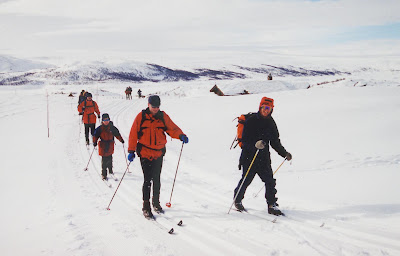 |
| skiing pictures |
Many different types of skiing are popular, especially in colder climates, and many types of competitive skiing events are recognized by the International Olympic Committee (IOC), the International Ski Federation (FIS), and other sporting organizations, such as the U.S. Ski and Snowboard Association in America. Skiing is most visible to the public during the Winter Olympic Games where it is a major sport.
In skiing's traditional core regions in the snowy parts of Scandinavia, as well as in places such as Alaska, both recreational and competitive skiing is as likely to refer to the cross-country variants as to the internationally downhill variants.
Skiing techniques are difficult to master, and accordingly there are ski schools that teach everything from the basics of turning and stopping safely to more advanced carving, racing, mogul or "bump" skiing and newer freestyle techniques. There are two primary types of downhill skiing – "telemark" and "alpine."
For beginning skiers learning under a trained instructor, skiing speeds are low, the terrain is not steep and is often well-manicured, and the risks are relatively low. For extreme skiers, testing their expert abilities against ever more challenging terrain, the risks may be much higher.
Alpine skiing
Alpine skiing is also called downhill skiing. Typically, downhill skiing takes place at a ski resort with specified ski pistes or ski runs. Ski resorts that offer downhill skiing exist all over the world in cold climate areas. Non-competitive alpine skiing is recreational skiing. Also in the category of Alpine skiing are the competitions known as Slalom, Giant Slalom (GS), Super-G (Super Giant Slalom) and Downhill.Freestyle skiing

Aerial freestyle
Freestyle/Newschool: Freestyle skiing is the type of skiing with which tricks are usually associated. The skis used are generally of a twin tip design, made to land switch tricks (backwards) as easily as forwards. Tricks are generally spins and flips, that can be conjoined with a grabbing of the ski to improve the image of the trick. Freestyle skiing generally takes place in terrain parks at ski resorts, with a wide variety of jumps, rails, jibs and other features to session. Mogul skiing is also considered as freestyle skiing.
Freeskiing/Freeride Related to freestyle skiing in nature is freeriding, which involves taking the tricks done in the park to the rest of the mountain and the backcountry. Thus, fatter skis may be used to float on top of the powder. Freeriding often involves steeps, cliffs, powder, glades, and other epic runs. In part due to the growing popularity of freestyle skiing in recent years and the obvious limitations in that aspect of the sport, freeride skiing has also been growing in popularity in recent years as more and more skiers have access to good backcountry gear and skis.
Nordic skiing

A ski jumper using the V-style near Calgary, Canada.
Cross country skiing : Priit Narusk in the qualification for the Tour de Ski in Prague.

Cross country skiing : Skiing tracks in snow in mountains in Sarek, Sweden.
Nordic Jumping: Also called ski-flying and ski jumping. A competition in which skiers slide down a ramp called a jump and attempt to go the furthest before landing on the ground. This is done with Nordic style skis, meaning that the heels of boot and binding are detached from the ski. The skis are much longer and wider than other types of skis and jumping is typically done without ski-poles. Telemark skiing: See also ski touring.
Military skiing
Military Skiing: In addition to its role in recreation and sport, skiing is also used as a means of transport by the military, and many armies train troops for ski warfare. Ski troops played a key role in retaining Finnish independence from Russia during the Winter War, and from Germany during the Lapland War, although the use of ski troops was recorded by the Danish historian Saxo Grammaticus in the 13th century. The sport of Biathlon was developed from military skiing patrols.Other types

Champion dry slope racer
Paraskiing is accomplished either by jumping from a plane or starting from a high altitude on the ground (i.e. – from a mountaintop). Once the parachute is deployed, it is used heavily for steering. Paraskiing has been a competition sport for years, and can be scored for such things as speed and slalom accuracy. This is very different from kite-skiing, as gravity is the sole means of propulsion, rather than wind, thermals, or motors.
Backcountry skiing: Also see ski touring
. Randonnée: See also ski touring, backcountry skiing.
Skijoring, also called Euro-style mushing, is skiing while being pulled by an animal(s), typically dogs or horses, or by snowmachine.
Dry Slope Skiing: This is skiing on artificial or dry snow, or dirt. Dry slope skiing is a year-round sport in countries like the UK where the snow cover is insufficient for traditional skiing. There is a thriving race programme on British slopes.
Adaptive Skiing is skiing done by individuals with physical disabilities. Adaptations to standard ski equipment or accompaniment by a non-disabled guide has enabled individuals with amputations, spinal injuries, TBI, deafness and visual impairments to ski, and in some cases, even race. The venue, speed and technical difficulty associated with the sport can lead to collisions, accidents, hypothermia and other injury or illness, occasionally including death. Regional Ski Patrol organizations, such as the National Ski Patrol in the U.S., exist as a voluntary organization to provide guidance, help, medical assistance and emergency rescue to those in need of it.








